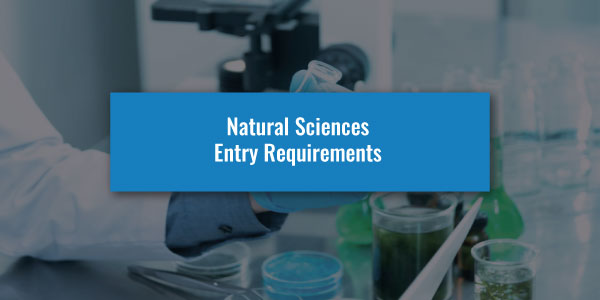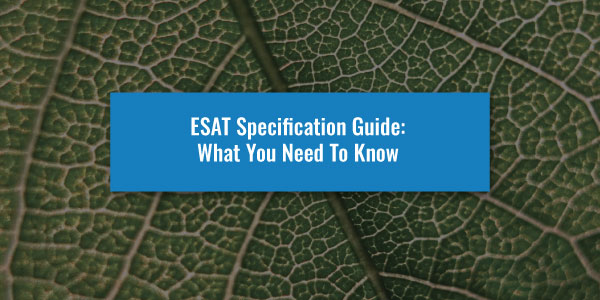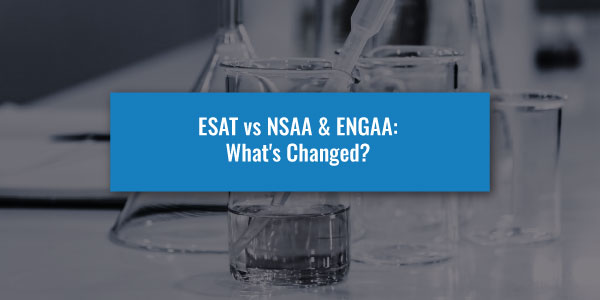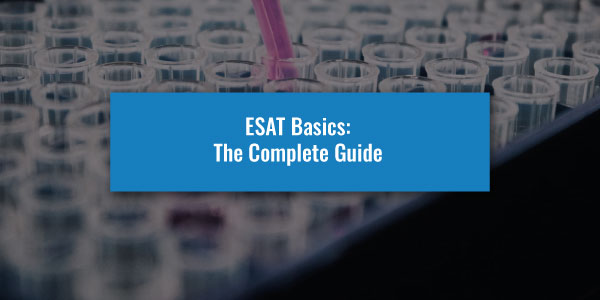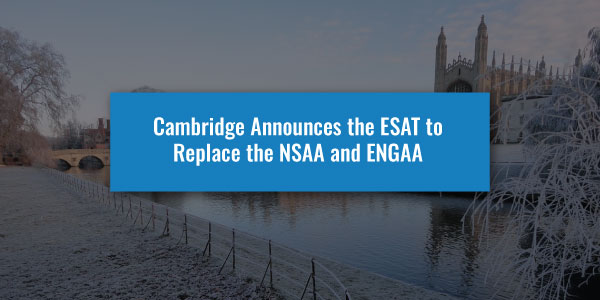The NSAA is being replaced by the ESAT exam. You can read more about the new exam here. NSAA past papers will still be useful when preparing for the ESAT.
The NSAA is an important part of the Natural Science and Veterinary Medicine admission – so understanding the Admission Test is essential.
Section 1 of the NSAA is split into four parts, with candidates required to answer Part A and one from B, C and D.
We will go over everything you need to know for Part A, which is all about Mathematics.
What Is Section 1A of the NSAA?
Section 1A of the Natural Science Admissions Assessment is all about Mathematics.
Being confident with Maths is extremely important for the NSAA. Many students find that improving their numerical and algebraic skills usually results in big improvements in their scores.
Even good students who are studying Maths at A2 can struggle with certain NSAA topics because they are typically glossed over at school.
Being confident with Maths is extremely important for the NSAA. Many students find that improving their numerical and algebraic skills usually results in big improvements in their scores.
What Maths Knowledge Do You Need For NSAA Section 1A?
It is important to know what knowledge you will be assumed to know to ensure you are using your revision time effectively.
You will not be given a formula sheet for the NSAA so you must know:
| 2D Shapes | 3D Shapes | |||
|---|---|---|---|---|
| Area | Surface Area | Volume | ||
| Circle | 𝜋𝑟2 | Cuboid | Sum of all 6 faces | Length x width x height |
| Parallelogram | 𝐵𝑎𝑠𝑒 × 𝑉𝑒𝑟𝑡𝑖𝑐𝑎𝑙 h𝑒𝑖𝑔ht | Cylinder | 2 𝜋𝑟2 + 2𝜋𝑟𝑙 | 𝜋𝑟2 𝑥 𝑙 |
| Trapezium | 0.5 × h × (𝑎 + 𝑏) | Cone | 𝜋𝑟𝑟2 + 𝜋𝑟𝑙 | 𝜋𝑟2 𝑥 (h/3) |
| Triangle | 0.5 × 𝑏𝑎𝑠𝑒 × h𝑒𝑖𝑔h𝑡 | Sphere | 4 𝜋𝑟2 | (4/3) 𝜋𝑟3 |
In addition to this is the topics that you will be required to know:
Quadratic Formula
The solutions for a quadratic equation in the form 𝑎𝑥² + 𝑏𝑥 + 𝑐 = 0 are given by: 𝑥 = −𝑏±√𝑏2−4𝑎𝑐/2𝑎
Remember that you can also use the discriminant to quickly see if a quadratic equation has any solutions:
𝐼𝑓 𝑏2 − 4𝑎𝑐 < 0: 𝑁𝑜 𝑠𝑜𝑙𝑢𝑡𝑖𝑜𝑛𝑠
𝐼𝑓 𝑏2 − 4𝑎𝑐 = 0: 𝑂𝑛𝑒 𝑠𝑜𝑙𝑢𝑡𝑖𝑜𝑛
𝐼𝑓 𝑏2 − 4𝑎𝑐 > 2: 𝑇𝑤𝑜 𝑠𝑜𝑙𝑢𝑡𝑖𝑜𝑛𝑠
Completing the Square
If a quadratic equation cannot be factorised easily and is in the format 𝑎𝑥² + 𝑏𝑥 + 𝑐 = 0 then you can rearrange it into the form 𝑎(𝑥+ 𝑏 /2𝑎 )²+[𝑐−𝑏² /4𝑎 ]=0
This looks more complicated than it is – remember that in the NSAA you are extremely unlikely to get quadratic equations where a > 1 and the equation does not have any easy factor.
Difference between 2 Squares
If you are asked to simplify expressions and find that there are no common factors but it involved square numbers – you might be able to factorise by using the “difference between two squares”.
For example, x2-25 can also be expressed as (𝑥+5)(𝑥-5).
Once you have mastered the above it would be worth also revising the following areas which cover a much broader knowledge of the A-Level Maths curriculum.
- Algebra
- Graphing Functions
- Law of Logarithms
- Differentiation
- Integration
- Geometry
- Series
- Trigonometry
Searching for NSAA support to strengthen your application?
The NSAA is a vital component of your Natural Science and Veterinary Science application so scoring highly can mean the difference between an offer or rejection. At UniAdmissions, we are experts at boosting your NSAA score and maximising your chances of gaining a place.
Discover our NSAA Programme by clicking the button below to enrol and triple your chances of success.
10 NSAA Section 1A Questions and Worked Solutions
Question 1
What is the circumference of a circle with an area of 10π?
- 2π√10
- π√10
- 10π
- 20π
- √10
- More information needed.
Answer: 1
𝐴 = 𝜋𝑟², therefore 10𝜋 = 𝜋𝑟
Thus, = √10
Therefore, the circumference is 2π√10
Question 2
If a.b = (ab) + (a + b) the calculate the value of (3.4).5
- 19
- 54
- 100
- 119
- 132
Answer: 4
3.4= 12 +(3+4)=19
19.5= 95 +(19+5)=119
Question 3
Which of the following graphs do not intersect?
y=x
y=x2
y=1-x2
y=2
- 1 and2
- 2 and 3
- 3 and 4
- 1 and 3
- 1 and 4
- 2 and 4
Answer: 3
Whilst you definitely need to solve this graphically, it is necessary to complete the square for the first equation to allow you to draw it more easily:
(𝑥 + 2)² = 𝑥²+ 4𝑥 + 4
Thus,𝑦=(𝑥+2)² +10= 𝑥² +4𝑥+14
This is now an easy curve to draw (y = x² that has moved 2 units left and 10 units up). The turning point of this quadratic is to the left and well above anything in x³, so the only solution is the first intersection of the two curves in the upper right quadrant around (3.4, 39).
Question 4
Calculate the product of 897,653 and 0.009764.
- 87646.8
- 8764.68
- 876.468
- 87.6468
- 8.76468
- 0.876468
Answer: 2
Notice that you’re not required to get the actual values – just the number’s magnitude. Thus, 897.653 can
be approximated to 900,000 and 0.009764 to 0.01. Therefore, 900,000 x 0.01 = 9,000, which represents the same magnitude of 8764.68.
Question 5
Solve the equation 𝑥2 − 10𝑥 − 100 = 0
- −5 ±5√5
- −5±√5
- 5 ±5√5
- 5±√5
- 5 ±5√125
- −5±√125
Answer: 3
The easiest way to do this is to ‘complete the square’:
(𝑥−5)² =𝑥²−10𝑥+25
Thus,(𝑥− 5)²− 125 = 𝑥²−10𝑥−100=0
Therefore, (𝑥 − 5)² = 125
𝑥−5 = ±√125= ±√25√5=±5√5
𝑥 = 5 ± 5√5
Question 6
The aspect ratio of my television screen is 4:3 and the diagonal is 50 inches. What is the area of my television screen?
- 1,200 inches²
- B. 1,000 inches²
- C. 120 inches²
- D. 100 inches²
- E. More information needed.
Answer: 1
Let the width of the television be 4x and the height of the television be 3x. Then by Pythagoras: (4𝑥)² + (3𝑥)² = 50²
Simplify: 25𝑥² = 2500
Thus: 𝑥 = 10. Therefore: the screen is 30 inches by 40 inches, i.e. the area is 1,200 inches² .
Question 7
The two inequalities 𝑥 + 𝑦 ≤ 3 𝑎𝑛𝑑 𝑥3 − 𝑦2 < 3 define a region on a plane. Which of the following points is inside the region?
- (2,1)
- (2.5, 1)
- (2.5, 1)(1,2)
- (3, 5)
- (1,2.5)
- None of the above.
Answer: 3
This is fairly straightforward; the first inequality is the easier one to work with: B and D and E violate it, so we just need to check A and C in the second inequality.
C:1³ -2² <3, but A:2³ -1² >3
Question 8
How many times do 𝑦 = 𝑥3 𝑎𝑛𝑑 𝑦 = 𝑥 intersect?
- 0
- 1
- 2
- 3
- 4
Answer: 4
It’s better to do this algebraically as the equations are easy to work with and you would need to sketch very accurately to get the answer. Intersections occur where the curves have the same coordinates. Thus: 𝑥³ = 𝑥
𝑥³− 𝑥 = 0
Thus: 𝑥(𝑥² − 1) = 0
Spot the ‘difference between two squares’: 𝑥(𝑥 + 1)(𝑥 − 1) = 0
Thus there are 3 intersections: at 𝑥= 0,1𝑎𝑛𝑑−1
Question 9
Fully factorise: 3a3 –30a2 + 75a
- 3a(a–3)³
- a(3a – 5)²
- 3a(a² –10a+25)
- 3a(a – 5)²
- 3a(a+5)²
Answer: 4
This is one of the easier maths questions. Take 3a as a factor to give: 3a(a² –10a+25) =3a(a–5)(a–5) =3a(a–5)²
Question 10
How many solutions are there for: 2(2(𝑥² − 3𝑥)) = −9 ?
- 0
- 1
- 2
- 3
- Infinite solutions.
Answer: 2
Expand the brackets to give: 4𝑥² − 12𝑥 + 9 = 0.
Factorise: (2𝑥 − 3)(2𝑥 − 3) = 0.
Thus, only one solution exists, x = 1.5.
Note that you could also use the fact that the discriminant, 𝑏² − 4𝑎𝑐 = 0 to get the answer.
Conclusion
Hopefully, this has given you a better understanding of what is in store with Section 1A of the NSAA.
What is important to remember is that all the knowledge you already know, it is about being able to apply it in new ways.
The questions provided should hopefully give you the opportunity to the test, as long as you do not peek at the answer too early as then you are only hindering yourself.
Best of luck for the NSAA!
Maximise your NSAA score through effective NSAA preparation.
The NSAA is a vital component of your Natural Science and Veterinary Science application so scoring highly can mean the difference between an offer or rejection. At UniAdmissions, we are experts at boosting your NSAA score and maximising your chances of gaining a place.
Discover our NSAA Programme by clicking the button below to enrol and triple your chances of success.


